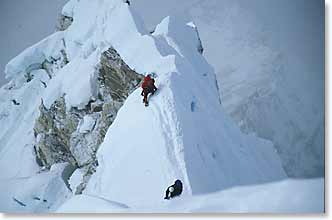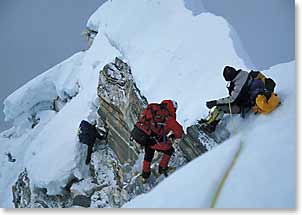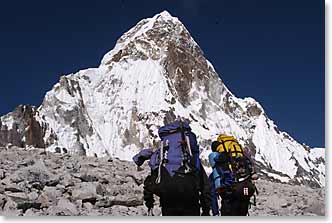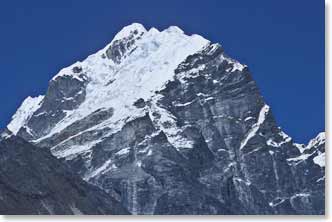
Climb Ama Dablam FAQ
Here is where you will find answers to some of your questions about this expedition. If you do not find what you need here, please contact us at info@bergadventures.com.
Choose the specific question to link to your answer
- When is the monsoon (rainy) season in Nepal?
- When is the best time to climb Ama Dablam
- Why do you climb in November, later in the season?
- What kind of physical fitness do I need to do this climb?
- How much mountaineering experience do I need? How demanding is the climb?
- Any suggestions for preparing/training for this climb
- Who is on your guiding team
- How much will my pack weigh?
- What is your approach for acclimatization?
- What are accommodations like in Kathmandu and while trekking?
- How many people per tent?
- Can we take showers during the trek? How do we clean ourselves?
- Could you give an example of a typical breakfast, lunch and dinner during the expedition
- Do you have access to radio communications for emergencies?
- 1. When is the monsoon (rainy) season in Nepal?

- The full monsoon season in Nepal is typically from mid-June to mid-September. July and August and the first half of September are the rainiest months.
- 2. When is the best time to climb Ama Dablam

- The fall is the preferred season because of warmer temperatures and better snow conditions on the route. There is less loose rock, making it safer and easier to move along the route in the fall.
- 3. Why do you climb in November, later in the season?

- In previous years October has been a month when it can be cloudy and rainy. November into early December is statistically the clearest days throughout that region of Nepal. We like to climb during a time when clear skies are highly probable throughout most of the day.

- 4. What kind of physical fitness do I need to do this climb?

- You need to be in excellent cardiovascular shape for trekking and climbing Lobuche Peak/Island Peak and Ama Dablam. In addition you are expected to move efficiently on technical terrain; even though you will be moving on fixed lines you will climb steep rock,
- 5. How much mountaineering experience do I need? How demanding is the climb?

 The climb is quite sustained in terms of being technically demanding. You will be on fixed lines but you need to be comfortable moving on steep terrain. There is a section of 5.7 rock which you will climb and remember that you will be climbing this grade at altitude which makes it even more difficult.
The climb is quite sustained in terms of being technically demanding. You will be on fixed lines but you need to be comfortable moving on steep terrain. There is a section of 5.7 rock which you will climb and remember that you will be climbing this grade at altitude which makes it even more difficult.- 6. Any suggestions for preparing/training for this climb

- Cardiovascular training is very important, there are several ways to gain cardiovascular fitness such as; running, swimming, cycling, hiking and step master. Hiking and step master are great training methods that allow you to add the weight of a pack to help simulate trekking and climbing with a pack during the expedition. In addition any rock and ice climbing you do prior to the expedition will also prepare you for Ama Dablam.
- 7. Who is on your guiding team

- Berg Adventures Ama Dablam team will be under the leadership of one of our experienced North American Himalayan guides. In addition we will have a team of Sherpas who are familiar with the route. There is always a high guide to climber ratio, allowing ample opportunity for a successful summit.
- 8. How much will my pack weigh?

- Your pack weight will change throughout the trip. You will want a medium size backpack (3100-4100 cubic inches or 50-65 liters) that can hold your layers of clothing for changing temperatures through the day. The porters and yaks who will carry your large duffel bags do not necessarily move faster than you do, and they almost always leave earlier in the morning than you will. The items you carry with you each day are largely what you need to be inactive, rather than what you need to hike in. The jacket and hat you wear before the sun hits in the morning, the camera and notebook you use to record your impressions during breaks and so on. Do not follow advice to bring a smaller pack so that you will carry less. Packs that are slightly larger distribute the weight on your back better and are much easier to pack (especially with cold fingers!).
- 9. What is your approach for acclimatization?

- You will notice on the itinerary that we take several days to walk from Lukla at 9,200 ft (2804 m) to Lobuche at 15,800 ft (4815 m). At Namche and Pheriche (11,400 ft and 14,000 ft) respectively we take rest days to allow our bodies to adapt to higher altitudes. This schedule combined with a conscientious attitude about paying attention to our own bodies and to one another has proven successful time after time.
- We have one of the best approaches to acclimatize for Ama Dablam. We
climb Lobuche Peak (6118 m/ 20,075ft) or Island Peak (20,305 feet / 6189
meters as a preparatory climb for Ama Dablam. This has been proven to be
a successful way to acclimatize and prepare for the southwest ridge of
Ama Dablam. Climbing a significant peak such as Lobuche/Island Peak prepares
you mentally and physically which will help you perform better on Ama Dablam.

- 10. What are accommodations like in Kathmandu and while trekking?

- Kathmandu: We stay at the Yak and Yeti hotel, or another of Kathmandu's finest hotels. Trekking: We stay in a combination of clean and friendly Sherpa lodges and our tents. Our own cook staff will prepare all meals.
- 11. How many people per tent?

- When we do camp we will be in North Face VE-25 tents; you will have a personal tent at base camp and two persons per tent higher on the route.
 12. Can we take showers during the trek? How do we clean ourselves?
12. Can we take showers during the trek? How do we clean ourselves? 
- Hot showers, with gravity fed water heated on gas stoves, are available throughout the Khumbu. In the lower villages such as Namche you will have solar heated showers in your private rooms in the lodges. As you go higher washing facilities become simpler, but are always available. At the highest altitudes the showers are less likely to be used because outside temperatures are cold but in these areas our Sherpa staff provides small quantities of heated washing water each day. Warm washing water and soap for hands is also provided before each meal (and we insist you use it!).
- 13. Could you give an example of a typical breakfast, lunch and dinner during the expedition

- Our Sherpa cooks are masters at preparing a variety of healthy meals. They use almost exclusively fresh, whole ingredients. Produce and staples are purchased in the Kathmandu Valley and transported to the Khumbu via helicopter charter. Fresh meat and other supplements are purchased in Namche or along the way. Vegetarians rarely have complaints on Nepal trekking trips. Meat is served, but is always an addition to the main courses. Dal Bhatt (rice with lentils) and several other local Nepalese and Tibetan dishes are featured throughout our trek. They quite often become the favourites and are the "most requested", but there are always other options at any meal where they are served.
- Typical day’s meals:
- Breakfast: Porridge, corn flakes, instant milk, fried eggs, toast with jam and butter, orange slices. Coffee, black tea and herbal tea, hot chocolate, tang
- Lunch: Yak steak with chips (french fries), rice with lentils, cauliflower, toast with peanut butter and jam, cookies, fresh apples, hot drinks and tang
- Afternoon Tea: Popcorn, saltine crackers with sliced cheese, hot drinks
- Dinner: Soup, pizza, fresh green beans, mashed potatoes, banana fritters, hot drinks
- 14. Do you have access to radio communications for emergencies?

- Our primary means of communication with Kathmandu and the rest of the world is our satellite phone. In addition to our phone, regular phone lines are available as far as Tangboche, pay sat phones are sometimes available all the way to Gorak Shep.
- We also transmit daily dispatches to our office where they are posted on our website. This is a great way for your family and friends to follow your adventure and stay updated with the team’s progress.

